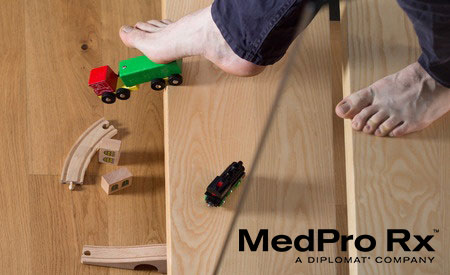Who hasn’t taken a spill on a slippery floor, or bumped into the coffee table in the middle of the night? For non-hemophiliacs, these injuries are usually minor—but for those with hemophilia or other bleeding disorders, a fall or injury can have more serious consequences.
Bruises are not always a cause for alarm, according to the World Federation of Hemophilia, but preventing as many as possible is a good idea nonetheless. Use these ideas to “hemophilia-proof” your life, and let us know if you have anything to add!

HOW TO PREVENT INJURIES IN KIDS
Toddlers and young children with hemophilia or another bleeding disorder can benefit from these tips to keep them safe.
- Protect your toddler with a helmet, elbow and kneepads. As your child learns to walk, he or she will stumble and fall—it’s only natural. Make sure those falls don’t require a trip to the emergency room by outfitting your child with a cute helmet and set of protective pads. (Why choose a cute option over the purely functional option? Your child will be more likely to want to wear his or her protective gear.)
- Lock drawers or cabinets containing sharp objects. Rummaging through drawers is a rite of passage, so keep kids from encountering sharp objects until they’re old enough to use them safely.
- Always use the included safety belts on car seats, strollers, and high chairs. Allow about an inch of wiggle room to keep your child comfortable but safe from falls.
- Buy children non-slip socks. Footwear with rubber or non-slip accents on the soles can help prevent accidents. Simply search “non-slip kids socks” on Google, or get creative and make your own!
HOW TO PREVENT INJURIES INSIDE
These simple tips will help you keep firm footing inside your house and avoid needless bruises.
- Use non-skid floor wax. Several brands of non-slip commercial wax are available; these can help make linoleum and other types of slippery flooring safer. If your wood floors have a buildup of old, oily cleaning products, clean them with a 1:1 solution of white vinegar and warm water (but test the solution on a small area first).
- Fasten rugs to the floor. To keep area rugs and throw rugs from sliding around when walked on, invest in rug pads or liners. Other options include latex adhesive tape and rubber rug backing. Just make sure that the type of backing you choose won’t damage your floor if you ever plan to move your rugs.
- Clearly mark raised thresholds or uneven flooring. Use a single stripe of brightly colored, nontoxic paint to differentiate raised thresholds from the floor surrounding them. If your home’s floors are lower or higher in spots, a colorful non-slip overlay, available from some commercial safety providers, can help.
- Prevent cords from extending into walking areas. Cut down on trip hazards by bundling electrical cords and cables together, and run them along the edges of the room.
- Consider adding “soft corners” to sharp pieces of furniture. Pieces of foam padding, taped around the edges of tables, bookshelves and other items with sharp corners, can help keep you or your child safe from accidents.
HOW TO PREVENT INJURIES OUTSIDE
Making your home a safe place is one thing, but how can you make the world safer for you? Here are some strategies to navigate a few slippery situations.
- Walk on the grass when the sidewalks are wet or icy. Along with posing less of a hazard, walking on grass instead of concrete may also be better for joint health.
- Sprinkle salt or cat litter on icy ground to add traction. While salt will melt ice, cat litter will simply absorb it. Note that salted ground can be toxic to pets, so those with dogs may wish to choose the cat-litter option.
- Always wear well-fitting, non-slip shoes. If your shoes are loose, you’ll be more prone to tripping or stumbling. Shoes with laces or ankle straps are a safe bet—and luckily, there are tons of styles for both men and women to choose from. If the soles of your shoes are slippery, add texture by rubbing them with sandpaper or applying grip spray, which is available online and at some shoe stores.
If you do slip and fall, follow the protocols you’ve discussed with your doctor. And if you’d prefer to cover up your bruises, check out our post on applying cover-up foundation and concealer.
